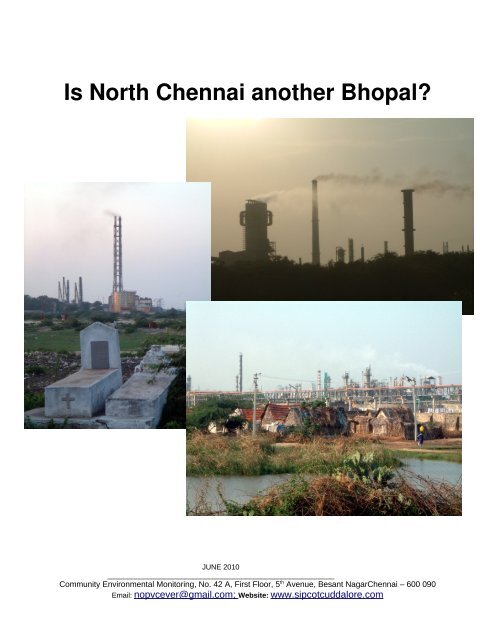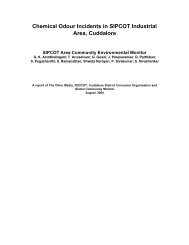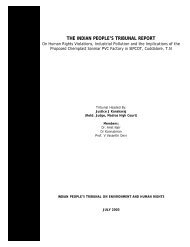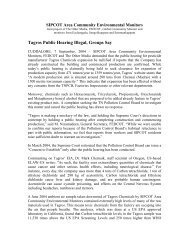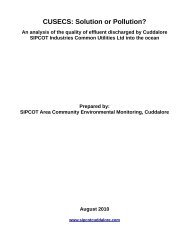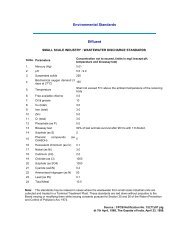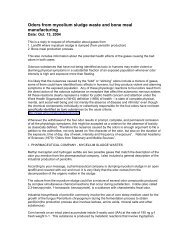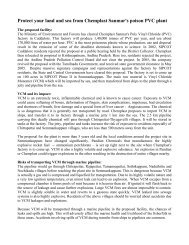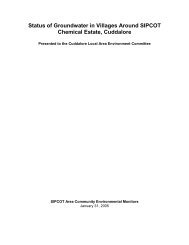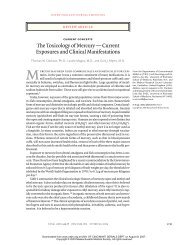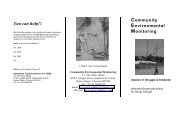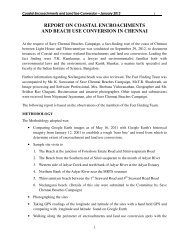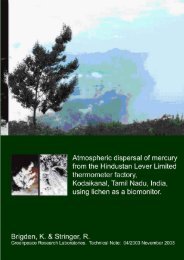Why is Cuddalore another Bhopal - SIPCOT Area Community ...
Why is Cuddalore another Bhopal - SIPCOT Area Community ...
Why is Cuddalore another Bhopal - SIPCOT Area Community ...
Create successful ePaper yourself
Turn your PDF publications into a flip-book with our unique Google optimized e-Paper software.
Is North Chennai <strong>another</strong> <strong>Bhopal</strong>?<br />
JUNE 2010<br />
________________________________________________________<br />
<strong>Community</strong> Environmental Monitoring, No. 42 A, First Floor, 5 th Avenue, Besant NagarChennai – 600 090<br />
Email: nopvcever@gmail.com; Website: www.sipcotcuddalore.com
Introduction<br />
In <strong>Bhopal</strong>, people were gassed to death in one night. In North Chennai, local residents are being<br />
exposed to po<strong>is</strong>onous gases on a daily bas<strong>is</strong> – a slow-motion <strong>Bhopal</strong>. So <strong>is</strong> North Chennai <strong>another</strong><br />
<strong>Bhopal</strong>? To answer that, one would need to see if the conditions that led to the 1984 Union Carbide<br />
d<strong>is</strong>aster in <strong>Bhopal</strong> apply to North Chennai.<br />
The <strong>Bhopal</strong> gas d<strong>is</strong>aster happened because hazardous and untested technologies were deployed in a<br />
thickly populated residential area. A hazardous, quick spreading gas was stored in large quantities in<br />
the factory. <strong>Community</strong> and worker complaints about pollution and unsafe workplace conditions were<br />
routinely ignored. The worst affected people were also politically the weakest, from religious minority,<br />
h<strong>is</strong>torically oppressed and economically vulnerable communities. 85 percent of those affected were<br />
working class people preoccupied with keeping their paltry daily wages coming. The community was<br />
kept in the dark, and even actively m<strong>is</strong>led about the hazardous chemicals and processes used in the<br />
Union Carbide factory. As a result, people were unable to respond appropriately when the d<strong>is</strong>aster<br />
struck. The regulators and the Government openly colluded with the industry to the extent that<br />
community members and workers that dared to complain about pollution were seen as trouble-makers<br />
and anti-development. Because many of the residents were squatters, and were constantly under fear<br />
of eviction, they dared not complain against pollution. Even 26 years after the gas d<strong>is</strong>aster, which has<br />
killed over 25,000 people and affected over 5 lakh people, children are being born deformed to<br />
parents exposed to toxic gases and continued exposure to contaminated soil and ground water<br />
around the abandoned factory.<br />
Consider North Chennai, especially around Manali, Ennore, Tiruvottiyur, Ambattur etc. Highly<br />
hazardous units have been and continue to be located in close proximity to residential areas. Local<br />
complaints about gas leaks, pollution and routine occurrence of hazardous incidents have not made a<br />
difference in the attitude of regulators or state planners. In many instances, these are never even<br />
reported or recorded by the authorities. The potential for a major fire <strong>is</strong> immense given the large<br />
quantities of petroleum products stored in tank farms dotting the area. Calamitous events involving<br />
volatile and hazardous gases are a d<strong>is</strong>tinct likelihood because large quantities of chemicals like<br />
ammonia, chlorine, benzene and hydrogen fluoride are stored in various factories.<br />
Environmental monitoring data released by Chennai-based <strong>Community</strong> Environmental Monitoring<br />
(CEM) in 2005 and 2007, showed the presence of highly toxic chemicals in the ambient air around the<br />
factories and residential areas. These too have been ignored by the industries and monitoring<br />
agencies. CEM reported presence of 14 highly toxic chemicals in the air samples: Hydrogen Sulphide,<br />
Carbon d<strong>is</strong>ulphide, ethanol, acetone, <strong>is</strong>o propyl alcohol, 2-butanone, n-hexane, benzene, toluene,<br />
ethyl benzene, m,p-xylenes, o-xylene, Bromomethane, Methyl Ethyl Ketone, Ethylbenzene, n-Nonane.<br />
All chemicals target the eyes, 11 chemicals target the skin, Central Nervous System and the<br />
respiratory system, 4 chemicals target the liver and kidneys, 3 chemicals target the blood, 2 chemicals<br />
target the Peripheral Nervous System, reproductive system and the gastrointestinal system and 1<br />
chemical affects the Cardio Vascular System. One chemical – benzene -- <strong>is</strong> a known human and<br />
animal carcinogen, which also causes a rare childhood cancer called leukemia or blood cancer.<br />
In 2005 Local <strong>Area</strong> Environment Committee (LAEC-Manali) constituted by Supreme Court appointed<br />
Monitoring Committee on Hazardous Wastes and Chemicals found large scale environmental<br />
violations by factories in Manali. LAEC reported that pollution from small scale industries had gone<br />
unchecked in the area and Tamil Nadu Pollution Control Board (TNPCB) did not even have a<br />
complete l<strong>is</strong>t of small industries operating in the area. The committee found illegal d<strong>is</strong>charge of oil<br />
(waste or otherw<strong>is</strong>e) from CPCL facility which had flown into the storm water channels, contaminated<br />
the soil and surrounding wetland vegetation. D<strong>is</strong>charge of untreated toxic effluents was a key problem<br />
identified by the committee. Test results of effluents from Futura Polymers’ bio-sludge showed<br />
Is North Chennai Another <strong>Bhopal</strong>?<br />
June 2010
presence of Cadmium, a toxic heavy metal known to cause kidney, lungs and liver damage in<br />
humans. Large piles of spent lime were found to be ind<strong>is</strong>criminately dumped all across the area.<br />
LAEC noted in their final report that community interactions had provided clear indication of ground<br />
water contamination and that situation has worsened since 1967. They also noted storage of large<br />
quantities of hazardous wastes like spent oil by MFL for very long periods of time, which <strong>is</strong> in violation<br />
of Hazardous Wastes (Storage and Handling) Rules 1989. Finally, the Committee had made various<br />
recommendations, none of which seems to have been implemented, including supply of clean drinking<br />
water to the residents as the groundwater of the area has been contaminated by illegal d<strong>is</strong>charges<br />
from the factories.<br />
These reports and monitoring data are by no means comprehensive. But they are an indicator that<br />
North Chennai <strong>is</strong> a slow-motion <strong>Bhopal</strong>, with po<strong>is</strong>onous gases tainting the everyday air of local<br />
residents and workers. They also ra<strong>is</strong>e <strong>is</strong>sues of environmental justice where highly hazardous<br />
industries are deliberately located in poorer neighbourhoods, where people have less bargaining<br />
power.<br />
While an accident like <strong>Bhopal</strong>, if it ever occurs in th<strong>is</strong> area, will cause similar or may be far greater<br />
calamity, what remains a key concern <strong>is</strong> the ‘slow po<strong>is</strong>oning’ of the people of North Chennai due to the<br />
toxics em<strong>is</strong>sions from these factories. Daily exposure to toxic chemicals even at low dosage will have<br />
long term impact on the health of the local residents which also includes the workers.<br />
<strong>Bhopal</strong> 1984; North Chennai 20?? – Will h<strong>is</strong>tory repeat itself?<br />
S Conditions <strong>Bhopal</strong> North Chennai<br />
No.<br />
1. Toxic facility Untested toxic facility to<br />
manufacture pesticide was set up<br />
in <strong>Bhopal</strong><br />
Various chemical industries have old<br />
and badly maintained plants to<br />
manufacture petrochemicals and bulk<br />
chemicals. Factories Inspectorate<br />
perm<strong>is</strong>sions are seldom sought prior to<br />
construction of factories.<br />
2. Location of the<br />
plant<br />
The plant was located in an area<br />
with dense population, with<br />
residential areas at a d<strong>is</strong>tance<br />
less than 50 mts from the unit<br />
The plants are located next to each<br />
other sandwiching at least 10 villages.<br />
More than 1,00,000 people reside in the<br />
immediate vicinity of the units.<br />
3. Type of <strong>Community</strong> Facility located in a working class<br />
neighbourhood with people from<br />
socially, economically and<br />
politically marginal<strong>is</strong>ed sections of<br />
society.<br />
North Chennai residents are<br />
predominantly working class, and from<br />
socially, economically and politically<br />
weaker sections of society.<br />
4 Insecure workers;<br />
Insecure residents<br />
4. No information<br />
about hazards<br />
Is North Chennai Another <strong>Bhopal</strong>?<br />
June 2010<br />
Workers fearful of job-loss;<br />
many residents were squatters<br />
without land-titles and hence<br />
apprehensive of eviction if they<br />
ra<strong>is</strong>ed their voices<br />
No information was shared with<br />
the community or workers about<br />
the products manufactured in the<br />
plant or the chemicals used.<br />
Communities knew little about<br />
d<strong>is</strong>aster response. Hazards and<br />
Most workers contract workers, and<br />
particularly vulnerable. Will be replaced<br />
at first sign of assertion. Many<br />
communities near the factory site are<br />
squatters who are fearful of eviction.<br />
No information has been shared with<br />
the communities about the products<br />
manufactured or chemicals used in the<br />
North Chennai industries. The<br />
community has been given no<br />
information or training on what to do in
dangers were underplayed to give<br />
a false sense of security.<br />
5. Complaints ignored Environmental pollution, cattle<br />
deaths, worker injuries and<br />
deaths due to workplace hazards<br />
were not taken seriously. No rootcause<br />
investigations were<br />
conducted.<br />
Routine accidents and hazardous<br />
incidents in the Union Carbide<br />
factory were ignored.<br />
the event of a d<strong>is</strong>aster. Serious gas<br />
leaks and spills are routinely d<strong>is</strong>m<strong>is</strong>sed<br />
as mere odour nu<strong>is</strong>ance. Fire service<br />
and hospital infrastructure uninformed<br />
and inadequate to deal even with minor<br />
incidents.<br />
Several hazardous incidents and<br />
illegalities have been reported in the<br />
past but no serious action on the<br />
violators have been taken. On one<br />
incident, the TNPCB itself referred to a<br />
gas leak from CPCL as routine,<br />
d<strong>is</strong>playing apathy towards<br />
environmental and human health.<br />
Chemicals detected in air samples (in Manali) and their health impacts (CEM 2005-07):<br />
S No Chemical found Odour<br />
Health Effects<br />
1. Hydrogen Sulphide<br />
A strong odour<br />
of rotten eggs<br />
Irritation eyes, respiratory system; convulsions; conjunctivit<strong>is</strong>,<br />
eye pain, dizziness, headache, weakness, exhaustion, irritability,<br />
gastrointestinal d<strong>is</strong>turbance<br />
2. Carbon D<strong>is</strong>ulphide<br />
A sweet etherlike<br />
odour<br />
Dizziness, headache, poor sleep, weakness, exhaustion, anxiety,<br />
weight loss; gastrit<strong>is</strong>; kidney, liver injury; eye, skin burns;<br />
dermatit<strong>is</strong>; reproductive effects<br />
3. Ethanol A pungent,<br />
fruity odour<br />
Irritation eyes, nose, throat; eye, skin burns; dermatit<strong>is</strong>; conjunctivit<strong>is</strong>;<br />
cough; central nervous system depression;; in animals:<br />
kidney, reproductive, teratogenic effects; [potential occupational<br />
carcinogen]<br />
4. Acetone A fragrant,<br />
mint-like odour<br />
Irritation eyes, nose, throat; headache, dizziness, central<br />
nervous system depression; dermatit<strong>is</strong><br />
5. Isopropyl Alcohol Odour of rubbing<br />
alcohol<br />
Irritation eyes, nose, throat; drowsiness, dizziness, headache;<br />
dry cracking skin<br />
6. 2-Butanone A moderately Irritation eyes, skin, nose; headache; dizziness; vomiting;<br />
Is North Chennai Another <strong>Bhopal</strong>?<br />
June 2010
(Methyl Ethyl<br />
Ketone)<br />
sharp, fragrant,<br />
mint- or acetone-like<br />
odour<br />
dermatit<strong>is</strong><br />
7. n-Hexane A gasoline-like<br />
odour<br />
Irritation eyes, nose; nausea, headache; muscle weakness;<br />
dermatit<strong>is</strong>; dizziness<br />
8. Benzene An aromatic<br />
odour<br />
Irritation eyes, skin, nose, dizziness; headache, nausea, exhaustion;<br />
bone marrow depression; [potential occupational carcinogen]<br />
9. Toluene A sweet, pungent,<br />
benzenelike<br />
odour<br />
Irritation eyes, nose; weakness, exhaustion, confusion, euphoria,<br />
dizziness, headache; d<strong>is</strong>charge of tears; anxiety, muscle fatigue,<br />
insomnia; liver, kidney damage<br />
10. Ethylbenzene An aromatic<br />
odour.<br />
Irritation eyes, skin, mucous membrane; headache; coma<br />
11. m,p- Xylenes An aromatic<br />
odour.<br />
Irritation eyes, skin, nose, throat; dizziness, excitement, drowsiness,<br />
incoordination, staggering gait; nausea, vomiting, abdominal<br />
pain; dermatit<strong>is</strong><br />
12. o-Xylene An aromatic<br />
odour.<br />
Irritation eyes, skin, nose, throat; dizziness, excitement, drowsiness,<br />
incoordination, staggering gait, nausea, vomiting, abdominal<br />
pain<br />
13. Bromomethane A chloroformlike<br />
odour at<br />
high concentrations<br />
Irritation eyes, skin, respiratory system; Central Nervous System<br />
depression; liver, kidney d<strong>is</strong>ease, cardiac arrest, [Potential occupational<br />
carcinogen]<br />
14. n-Nonane NA NA<br />
Is North Chennai Another <strong>Bhopal</strong>?<br />
June 2010
Status of consent to operate (under Water and Air Act) status of industries in Manali and<br />
Ennore (partial l<strong>is</strong>t):<br />
Manali<br />
Name of Industry<br />
Consent Status<br />
M/s. Manali Petrochemicals Ltd. Consent expired in 30.9. 2009<br />
M/s. Kothari Petro Chemicals Ltd. Consent expired in 31.3. 2009<br />
M/s. Inox Air Products Ltd. Consent expired on 31.3.2010<br />
M/s. SRF Polymers Limited Consent expired in 31.3.2008<br />
M/s. SRF Limited Consent expired in 31.3. 2007<br />
M/s. Balmer Lawrie & Co. Limited Consent expired on 30.9.2009<br />
M/s Chennai Petroleum Corporation Limited Consent expired on 30.9.2009<br />
M/s. Tamil Nadu Petro Products Limited Consent expired on 30.3.2010<br />
M/s TPL (Epi -chloro hydrin Plant) Consent expired on 30.9.2009<br />
M/s. Pure Industrial Gases P Ltd. Consent expired on 31.3.2010<br />
M/s. Goyal Metal Industries P Ltd. Consent expired on 30.9.2009<br />
M/s. Balmer Lawrie & Co., (Barrel Divn) Consent expired on 31.3.2010<br />
M/s.Sudhanthira Devi Dhall Mill Sathangadu, Consent expired on 30.9.2008<br />
Manali<br />
M/s. S.T. Shanmugam Snuff Co. Consent expired on 30.9.2008<br />
M/s. Pure Industrial Gases P Ltd Consent expired on 31.3.2010<br />
M/s. Goyal Metal Industries P Ltd Consent expired on 30.9.2009<br />
M/s.J.B.Steel Industries Consent expired on 30.6.2009<br />
M/s. Mirra & Mirra Industries Consent expired on 31.3.2007<br />
M/s.Sree Karumari Steel Industries Consent expired on 31.3.2007<br />
M/s. Dev Industries Consent expired on 31.3.2006<br />
M/s. MFPL Flourine Products<br />
M/s Futura Polymers Ltd.<br />
M/s Madras Fertilizers Ltd<br />
ENNORE:<br />
Name of Industry<br />
Consent Status<br />
M/s. Ennore Pr lmited<br />
M/s. Ennore Foundaries Ltd. (Power Plant) No info<br />
M/S.Coromandel Fertilizers Ltd Consent expired on 31.10.2009<br />
Ennore Thermal Power Station Consent expired on 31.3.2010<br />
Is North Chennai Another <strong>Bhopal</strong>?<br />
June 2010


